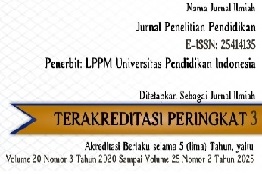Analisa Konten Visual dalam Kategori Gender
Abstract
Penelitian ini bertujuan menginvestigasi dan meneliti representasi gender di buku teks Sekolah Menengah Indonesia berjudul When English Rings a Bell untuk kelas VII. Metode penelitian ini menggunakan analisa konten visual, ilustrasi bergambar dianalisa menggunakan kategori gender. Riset ini menggunakan tiga kategori gender yaitu kegiatan waktu luang atau permainan, sifat kepribadian dan tempat atau locus untuk menginvestigasi representasi gender. Hasil penelitian menunjukkan bahwa di setiap kategori gender, representasi perempuan selalu lebih rendah dibandingkan representasi lelaki. Buku teks juga tidak responsif terhadap gender karena cenderung tidak seimbang dalam ilustrasinya.
Keywords
Full Text:
PDFReferences
Ansary, H. & Babaii, E. (2003). Subliminal Sexism in Current ESL/EFL Textbooks. Asian EFL Journal, 5(1)1-15.
Arikan, A. (2005). Age, Gender and Social Class in ELT Coursebooks: A critical study. Hacettepe Üniversitesi Eğitim Fakültesi Dergisi, 28(28), 29-38.
Baldwin, P., & Baldwin, D. (1992). The Portrayal of Women in Clasroom Textbooks. Canadian Social Studies, 26(3), 110-114.
Berns, R. M. (2009). Child, Family, School, Community: Socialization and Support (Eight ed). Belmont: Wadsworth.
Clark, I. (2016). A Qualitative Analytic Case Study of Subliminal Gender Bias in Japanese ELTs. SAGE Open, 6(3).
DiktaĢ, M. (2011). Gender Representation in EFL Coursebooks, 2nd International Conference on New Trends in Education and Their Implications 27-29. Turkey: Antalya.
Fagot, B. I. (1995). Psychosocial and Cognitive Determinants of Early Gender-Role Development. Annual Review of Sex Research, 6, 1-31.
Farah, I., & Shera, S. (2007). Female Education in Pakistan: A Review. In R. Qureshi, & J. F. Rarieya, Gender and Education in Pakistan (pp. 3-40). Karachi: Oxford University Press.
Giaschi, P. (2000). Gender Positioning in Education: A Critical Image Analysis in ESL Texts. TESL Canada Journal / Revue TESL Du Canada, 18(1).
Hartman, P. L., & Judd, E. L. (1978). Sexism and TESOL materials. Tesol quaterly, 383-393.
Hossain, A. T. (2018). Depiction of Gender in ELT Textbooks: Gender Stereotyping in Language and Its Effect on Secondary Level Students. [Thesis, B.A. (English and Humanities)]. BRAC University: Department of English and Humanities, Retrieved from: http://hdl.handle.net/10361/10756.
Hsieh, H. F., & Shannon, S. E. (2005). Three Approaches to Qualitative Content Analysis. Qualitative health research, 15(9), 1277-1288.
Jabeen, S., & Ilyas, A. (2012). Gender Role Modelling in Textbooks: Case Study of Urdu Textbooks of Sindh Province. Pakistan Journal of Women's Studies, 19(1), 75-93.
Nachimas, D., & Nachimas, C. (1976). Content Analysis in Research Methods in the Social Sciences. UK: Edward Arnold.
Rifkin, B. (1998). Gender Representation in Foreign Language Textbooks: A Case Study of Textbooks of Russian. The Modern Language Journal, 82(2), 217-236.
Ruble, D. N., Martin, C. L., & Berenbaum, S. (2006). Gender Development. In N. Eisenberg, Handbook of child psychology (Sixth ed., Vol. 3). New York: Wiley.
Shaw, S. M. (1985). Gender and Leisure: Inequality in the Distribution of Leisure Time. Journal of leisure research, 17(4), 266-282.
Söğüt, S. (2018). Gender representation in high school EFL coursebooks: An investigation of job and adjective attribution. Abant İzzet Baysal Üniversitesi Eğitim Fakültesi Dergisi, 18(3), 1722-1737.
Söylemez, A. S. (2010). A Study on How Social Gender is Constructed in EFL coursebooks. Procedia-Social and Behavioral Sciences, 9, 747-752.
Srivastava, G. (2005). Gender concern in the social studies textbooks of Pakistan and Bangladesh. Internationale Schulbuchforschung, 27(2), 217-234.
Sumalatha, K., & Ramakrishnaiah, D. (2004). Sex bias in secondary school social studies textbooks: A case study in India. American Journal of Applied Science, 1(1), 62-63.
Thome, B. (1993). Gender play: Grls and boys. NJ: Rutgers Univ. Press.
Toçi, A., & Aliu, M. (2013). Gender Stereotypes in Current's English Books used in Elementary Schools in the Republic of Macedonia. American International Journal of Contemporary Research, 3(12), 32-38.
Turgut, M. & Yilmaz, S. (2012). Relationship among Preservice Promary Mathematics Teachers' Gender, Academic Success, and Spatial Ability. International Journal of Instruction, 5(2), 5-20.
Wachidah, S., Gunawan, A., Khatimah, Y. R., & Diyantari, D. (2013). Bahasa Inggris, When English Rings a Bell: Buku Guru SMP/MTs Kelas VIII. Jakarta: Kementrian Pendidikan dan Kebudayaan.
Yang, C. C. (2011). Gender Representation in a Hong Kong Primary English Textbook Series: The Relationship between Language Planning and Social Policy. Current Issues in language planning, 12(1), 77-88.
DOI: https://doi.org/10.17509/jpp.v20i2.22400
Refbacks
- There are currently no refbacks.
Copyright (c) 2020 Jurnal Penelitian Pendidikan


